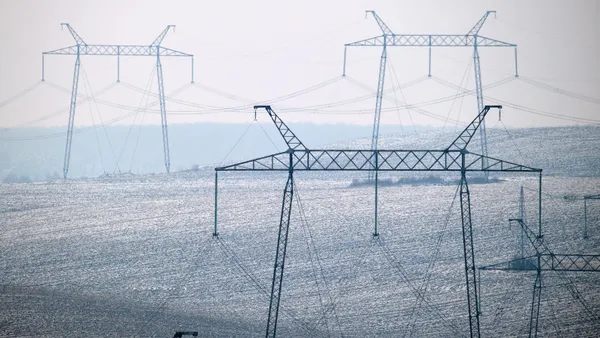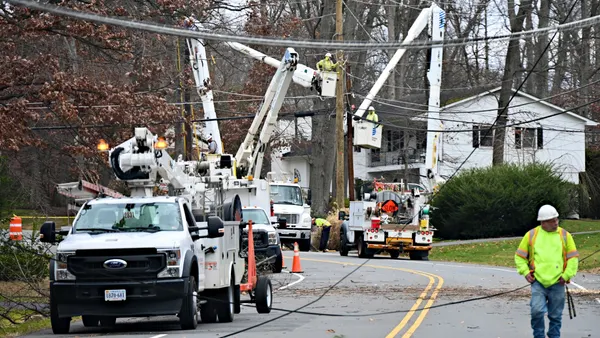Dive Brief:
- California’s investor-owned utilities are planning to spend nearly $11 billion in 2021 and 2022 on programs aimed at reducing the risk of wildfires in their service territories, according to annual wildfire mitigation plans filed with the California Public Utilities Commission (CPUC) late last week.
- These programs outline several strategies, including inspecting and repairing equipment, trimming back trees and other vegetation that could fall into power lines, and investing in grid technologies and system “hardening.” The utilities are also aiming to reduce the impact of public safety power shut-offs (PSPS) on their customers.
- California experienced a record-breaking wildfire season in 2020, with nearly 10,000 fires that burned over 4.2 million acres of the state by the end of the year. Last September, wildfire activity prompted S&P Global Ratings to lower the outlook for the state’s three investor-owned utilities to negative.
Dive Insight:
Utilities in California are required to prepare annual wildfire mitigation plans, which are then reviewed for approval by the CPUC’s wildfire safety division. The utilities filed the last iteration of their plans in February 2020, outlining a host of strategies that they intended to implement through 2022 in high fire-risk portions of their service areas.
Pacific Gas & Electric’s (PG&E) 2021 plan will focus on addressing various shortcomings that the utility, the wildfire safety division and its court-appointed federal manager identified in its fire prevention programs last year, the utility said in its filing. These relate to its vegetation management work as well as prioritizing and timing its system inspections.
Among other things, the utility is deploying a new risk model to analyze and prioritize its wildfire mitigation work, which could lead to a shift in where it conducts fire safety work in the coming years, Debbie Powell, interim head of electric operations, said in a statement. In total, PG&E estimates that its wildfire mitigation work will cost $6 billion in 2021 and 2022, according to a press release.
Southern California Edison's (SCE) 2021 plan focuses on similar strategies; among other things, the utility plans to install an additional 1,000 to 1,400 miles of insulated powerlines and install 375 weather stations in its service territory. Last year, SCE spent $1.3 billion on its fire prevention work, and it expects to spend another $3.5 billion in 2021 and 2022.
“Over the last several years we’ve dramatically changed both the frequency and the rigor with which we inspect our infrastructure in high fire risk areas,” said Phil Herrington, senior vice president of transmission and distribution. He added that this year, the utility will inspect more than 240,000 structures — roughly 60% of its distribution and 50% of its transmission infrastructure — that it estimates accounts for 99% of the risk it faces.
San Diego Gas & Electric (SDG&E), meanwhile, plans to spend over $646 million in 2021 and nearly $670 million in 2022 on its fire mitigation work. The utility intends to continue with many of the programs it initiated last year, including improving its outreach to vulnerable communities as well as data collection and analyses processes.
A key priority is reducing the impact of public safety power shut-offs on their customers. PG&E, for instance, is investing in better weather monitoring technology to more precisely forecast when these shut-offs could occur, installing devices to limit the size of the shut-offs, and employing microgrids to help power communities during the outages.
Last month, the CPUC held a meeting to discuss the regulators’ concerns over SCE’s deployment of its shut-offs, including a lack of transparency around the utility’s decision-making process, and its communications with customers and government entities. This year, the utility is aiming to reduce the number of customers affected by safety shut-offs by 27,000 compared to 2020.
As the utility continues to deploy its wildfire mitigation measures, Herrington expects to see a dramatic drop-off in terms of how often PSPS events are rolled out. But “I don’t know if you ever get to zero, because there’s other things at play here that we don’t have an answer to, and that is how much worse could wildfire conditions get as climate change worsens,” Herrington said.
Some stakeholders, however, remain concerned about how effective the plans will be. One of the most cost-effective and efficient approaches to reducing wildfire risk is system hardening, said April Rose Maurath Sommer, executive and legal director of the Wild Tree Foundation. System hardening includes a combination of switching out bare conductors with covered conductors, installing stronger poles and undergrounding portions of power lines. In 2020, PG&E hardened 342 miles of powerlines. This year, however, the utility is aiming to complete 180.
“What we would want to see is PG&E ramping up and doing more and more — instead, they actually are doing less,” Maurath Sommer said, adding that the utility’s plan to complete between 450 and 500 miles of system hardening per year by 2024 and after is “still a drop in the bucket."
"The fires that have caused the most harm previously have been the result of utilities' criminal negligence and mismanagement. The plans are meaningless if the companies can't complete the work effectively and correctly, which has sadly not been the case in the past," Mindy Spatt, communications chief at ratepayer advocacy group The Utility Reform Network, said in an email.














